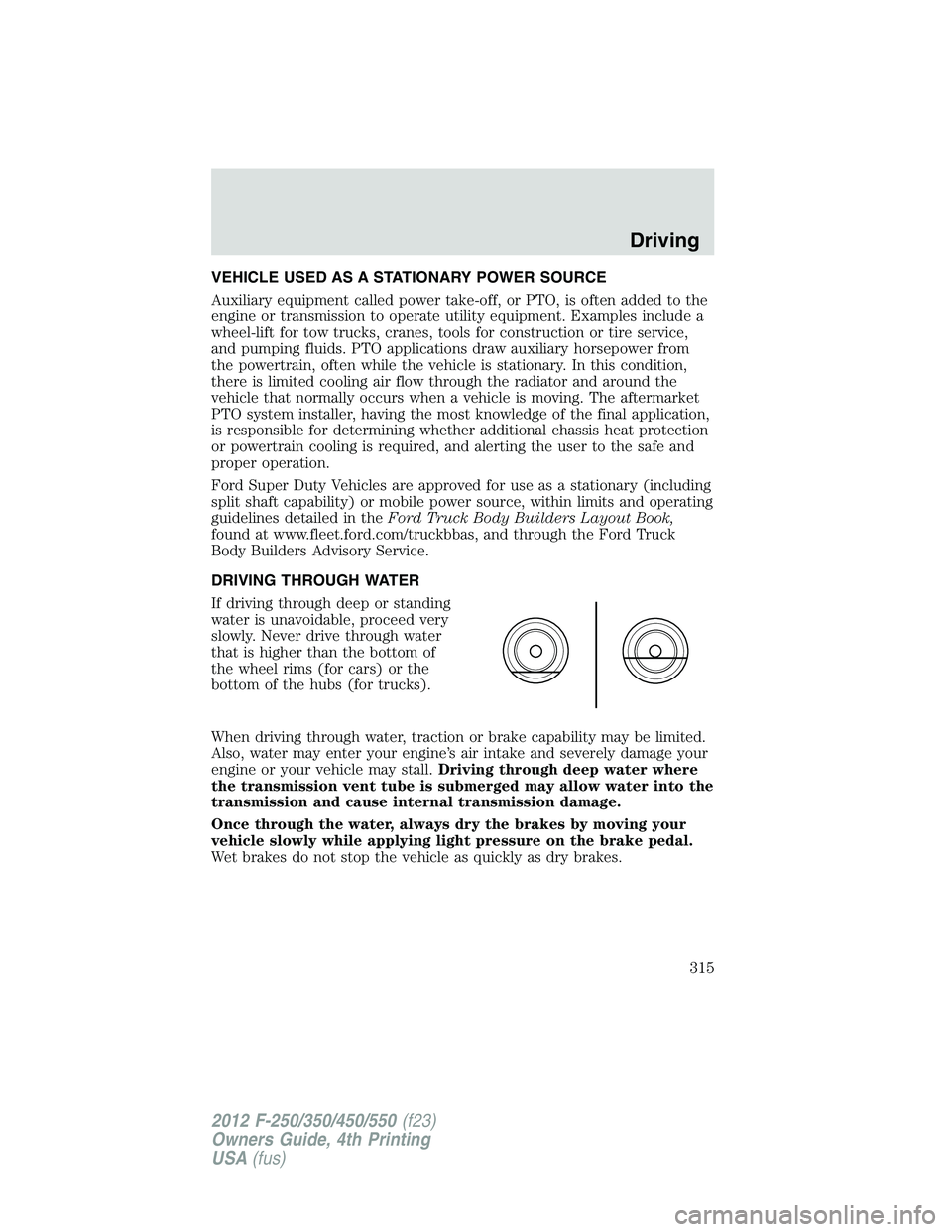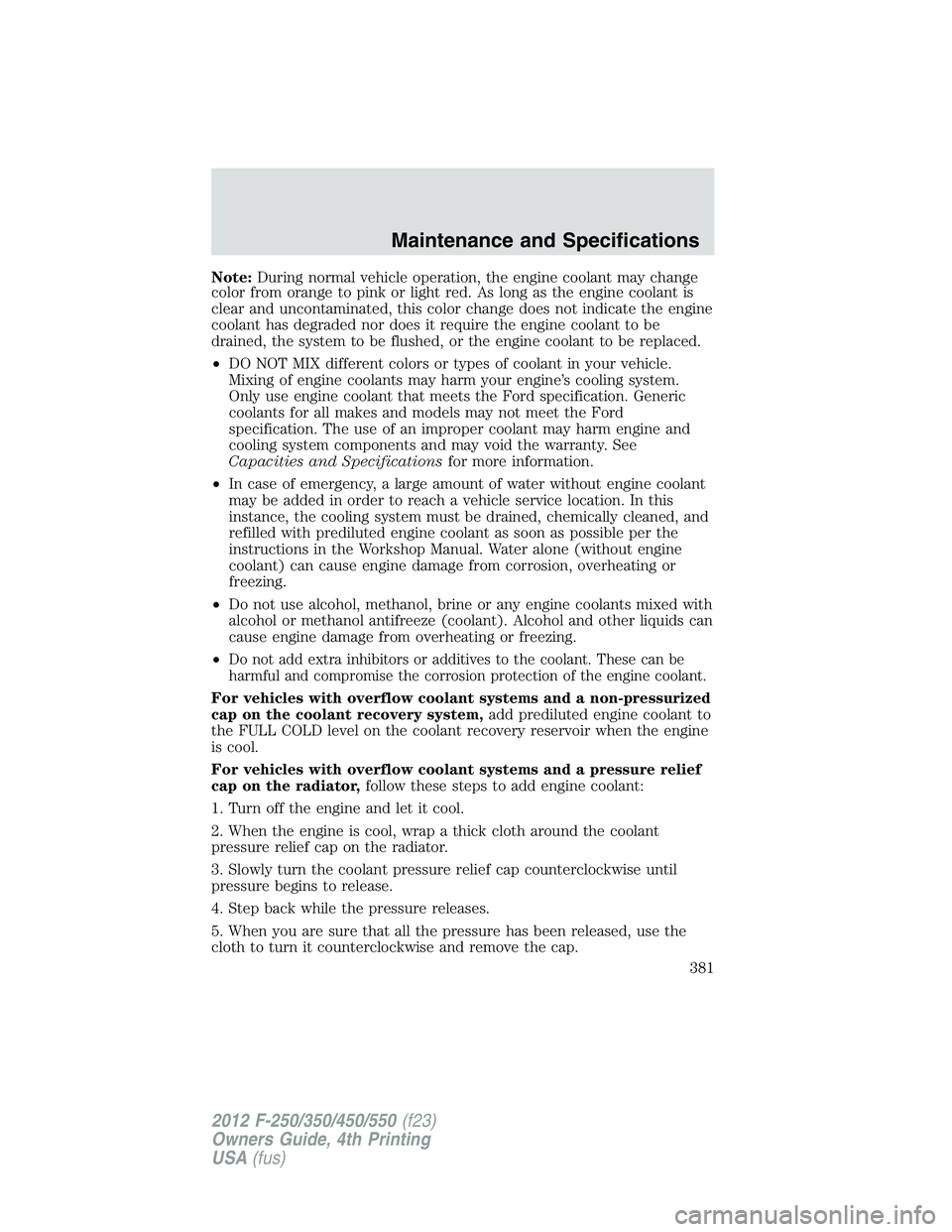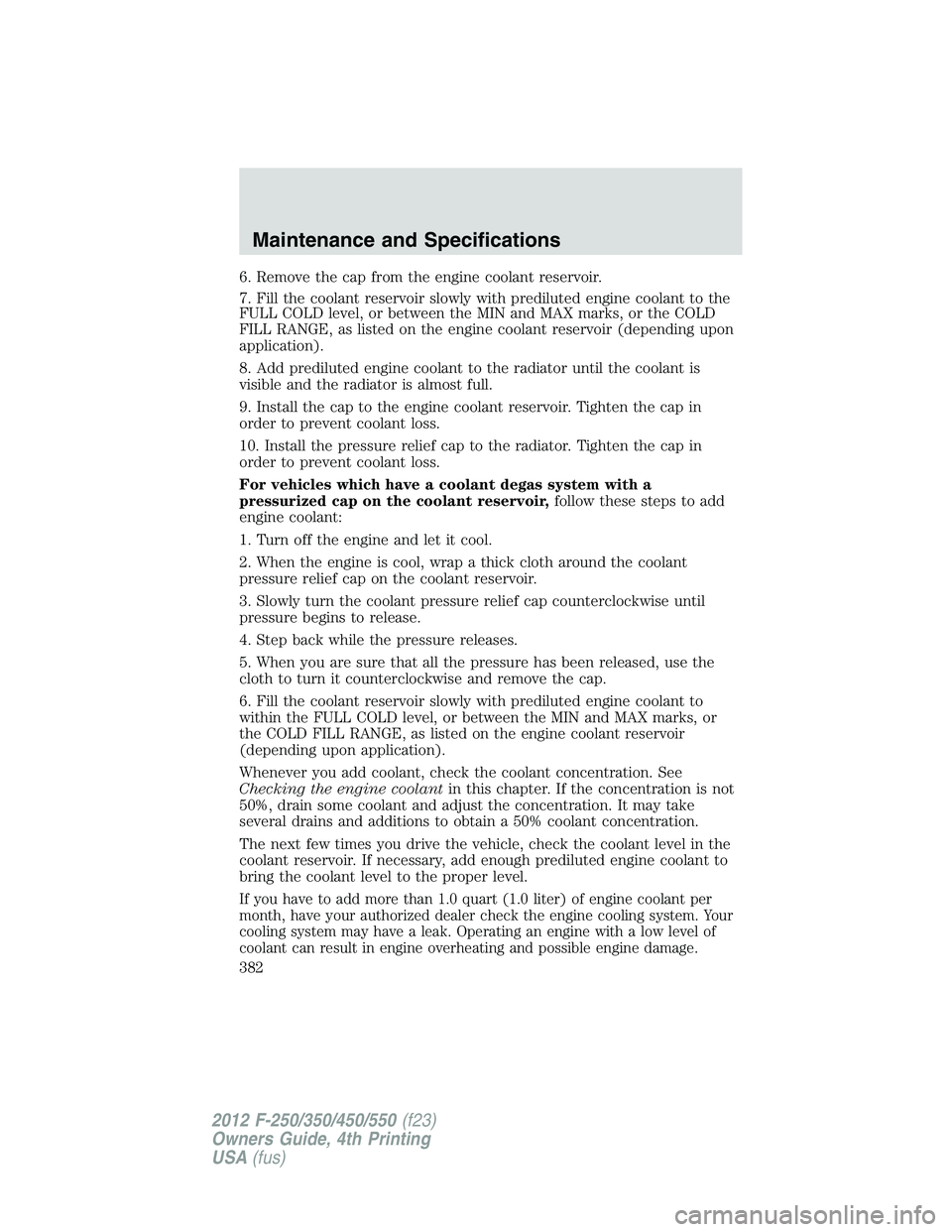Page 315 of 448

VEHICLE USED AS A STATIONARY POWER SOURCE
Auxiliary equipment called power take-off, or PTO, is often added to the
engine or transmission to operate utility equipment. Examples include a
wheel-lift for tow trucks, cranes, tools for construction or tire service,
and pumping fluids. PTO applications draw auxiliary horsepower from
the powertrain, often while the vehicle is stationary. In this condition,
there is limited cooling air flow through the radiator and around the
vehicle that normally occurs when a vehicle is moving. The aftermarket
PTO system installer, having the most knowledge of the final application,
is responsible for determining whether additional chassis heat protection
or powertrain cooling is required, and alerting the user to the safe and
proper operation.
Ford Super Duty Vehicles are approved for use as a stationary (including
split shaft capability) or mobile power source, within limits and operating
guidelines detailed in the Ford Truck Body Builders Layout Book,
found at www.fleet.ford.com/truckbbas, and through the Ford Truck
Body Builders Advisory Service.
DRIVING THROUGH WATER
If driving through deep or standing
water is unavoidable, proceed very
slowly. Never drive through water
that is higher than the bottom of
the wheel rims (for cars) or the
bottom of the hubs (for trucks).
When driving through water, traction or brake capability may be limited.
Also, water may enter your engine’s air intake and severely damage your
engine or your vehicle may stall. Driving through deep water where
the transmission vent tube is submerged may allow water into the
transmission and cause internal transmission damage.
Once through the water, always dry the brakes by moving your
vehicle slowly while applying light pressure on the brake pedal.
Wet brakes do not stop the vehicle as quickly as dry brakes. Driving
315
2012 F-250/350/450/550 (f23)
Owners Guide, 4th Printing
USA (fus)
Page 381 of 448

Note: During normal vehicle operation, the engine coolant may change
color from orange to pink or light red. As long as the engine coolant is
clear and uncontaminated, this color change does not indicate the engine
coolant has degraded nor does it require the engine coolant to be
drained, the system to be flushed, or the engine coolant to be replaced.
• DO NOT MIX different colors or types of coolant in your vehicle.
Mixing of engine coolants may harm your engine’s cooling system.
Only use engine coolant that meets the Ford specification. Generic
coolants for all makes and models may not meet the Ford
specification. The use of an improper coolant may harm engine and
cooling system components and may void the warranty. See
Capacities and Specifications for more information.
• In case of emergency, a large amount of water without engine coolant
may be added in order to reach a vehicle service location. In this
instance, the cooling system must be drained, chemically cleaned, and
refilled with prediluted engine coolant as soon as possible per the
instructions in the Workshop Manual. Water alone (without engine
coolant) can cause engine damage from corrosion, overheating or
freezing.
• Do not use alcohol, methanol, brine or any engine coolants mixed with
alcohol or methanol antifreeze (coolant). Alcohol and other liquids can
cause engine damage from overheating or freezing.
• Do not add extra inhibitors or additives to the coolant. These can be
harmful and compromise the corrosion protection of the engine coolant.
For vehicles with overflow coolant systems and a non-pressurized
cap on the coolant recovery system, add prediluted engine coolant to
the FULL COLD level on the coolant recovery reservoir when the engine
is cool.
For vehicles with overflow coolant systems and a pressure relief
cap on the radiator, follow these steps to add engine coolant:
1. Turn off the engine and let it cool.
2. When the engine is cool, wrap a thick cloth around the coolant
pressure relief cap on the radiator.
3. Slowly turn the coolant pressure relief cap counterclockwise until
pressure begins to release.
4. Step back while the pressure releases.
5. When you are sure that all the pressure has been released, use the
cloth to turn it counterclockwise and remove the cap. Maintenance and Specifications
381
2012 F-250/350/450/550 (f23)
Owners Guide, 4th Printing
USA (fus)
Page 382 of 448

6. Remove the cap from the engine coolant reservoir.
7. Fill the coolant reservoir slowly with prediluted engine coolant to the
FULL COLD level, or between the MIN and MAX marks, or the COLD
FILL RANGE, as listed on the engine coolant reservoir (depending upon
application).
8. Add prediluted engine coolant to the radiator until the coolant is
visible and the radiator is almost full.
9. Install the cap to the engine coolant reservoir. Tighten the cap in
order to prevent coolant loss.
10. Install the pressure relief cap to the radiator. Tighten the cap in
order to prevent coolant loss.
For vehicles which have a coolant degas system with a
pressurized cap on the coolant reservoir, follow these steps to add
engine coolant:
1. Turn off the engine and let it cool.
2. When the engine is cool, wrap a thick cloth around the coolant
pressure relief cap on the coolant reservoir.
3. Slowly turn the coolant pressure relief cap counterclockwise until
pressure begins to release.
4. Step back while the pressure releases.
5. When you are sure that all the pressure has been released, use the
cloth to turn it counterclockwise and remove the cap.
6. Fill the coolant reservoir slowly with prediluted engine coolant to
within the FULL COLD level, or between the MIN and MAX marks, or
the COLD FILL RANGE, as listed on the engine coolant reservoir
(depending upon application).
Whenever you add coolant, check the coolant concentration. See
Checking the engine coolant in this chapter. If the concentration is not
50%, drain some coolant and adjust the concentration. It may take
several drains and additions to obtain a 50% coolant concentration.
The next few times you drive the vehicle, check the coolant level in the
coolant reservoir. If necessary, add enough prediluted engine coolant to
bring the coolant level to the proper level.
If you have to add more than 1.0 quart (1.0 liter) of engine coolant per
month, have your authorized dealer check the engine cooling system. Your
cooling system may have a leak. Operating an engine with a low level of
coolant can result in engine overheating and possible engine damage.Maintenance and Specifications
382
2012 F-250/350/450/550 (f23)
Owners Guide, 4th Printing
USA (fus)